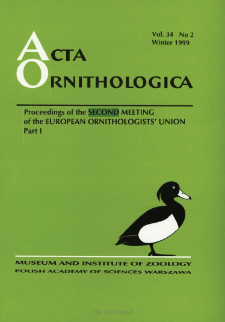- Search in all Repository
- Literature and maps
- Archeology
- Mills database
- Natural sciences
Advanced search
Advanced search
Advanced search
Advanced search
Advanced search

Object
Title: Breeding losses in an urban population of the collared dove Streptopelia decaocto in Słupsk, Poland
Creator:
Górski, Wojciech (1946–2001) ; Antczak, Jacek (ornitologia)
Date issued/created:
Resource type:
Subtitle:
Acta Ornithologica, vol. 34, no. 2 ; Straty lęgowe miejskiej populacji sierpówki w Słupsku
Contributor:
Polska Akademia Nauk. Muzeum i Instytut Zoologii ; Meeting of the European Ornithologists' Union (2 ; 1999 ; Gdańsk)
Publisher:
Muzeum i Instytut Zoologii PAN
Place of publishing:
Description:
Referat wygłoszony na Second Meeting of the European Ornithologists' Union ; Bibliogr. p. 194-195 ; P. [191-198] : ill. ; 27 cm ; Abstract in Polish. Taxa in Latin
Type of object:
Abstract:
During the 25 seasons (1974-1998), the breeding success of Collared Doves was determined by tracing the fates of 7882 nests found in S3upsk, Northern Poland. The kind of losses recognized were: complete nesting failures (CNF) and partial losses (PL), where only one nestling left the nest. Total breeding losses (TBL), were estimated by comparing the estimated total number of eggs laid (TNEL), with the total number of young fledged. In different years CNF varied from 51.8 to 75.7% ( = 61.1, SD = 5.1, n = 25 seasons, CV = 8%) while PL accounted for between 4.3 and 11.8% ( = 8.2, SD = 1.6, n = 25, CV = 19.5 %) of all eggs laid. TBL amounted to between 60.9 and 80% ( = 69.3, SD = 4.3, n = 25, CV = 6.2 %) of TNEL, and was highest at the beginning (February-April) of the breeding season, and at the end (September-October). The losses suffered during incubation ( = 70.6%, SD = 10.3, n = 25, CV = 15%) were much higher than at the nestling stage ( = 29.4%, SD = 10.3, n = 25, CV = 35%). Rooks and Jackdaws were the main nest predators of the Collared Dove population in S3upsk, while Magpies and domestic cats were less effective predators.
Relation:
Volume:
Issue:
Start page:
End page:
Detailed Resource Type:
Format:
Resource Identifier:
Source:
MiIZ PAN, call no. P.257, Vol. 34, No 2 ; MiIZ PAN, call no. P.4568, Vol. 34, No 2 ; click here to follow the link
Language:
Rights:
Creative Commons Attribution BY 3.0 PL license
Terms of use:
Digitizing institution:
Museum and Institute of Zoology of the Polish Academy of Sciences
Original in:
Library of the Museum and Institute of Zoology of the Polish Academy of Sciences
Projects co-financed by:
Programme Innovative Economy, 2010-2014, Priority Axis 2. R&D infrastructure ; European Union. European Regional Development Fund
Access:
Object collections:
- Digital Repository of Scientific Institutes > Partners' collections > Museum and Institute of Zoology PAS > Scientific Journals
- Digital Repository of Scientific Institutes > Partners' collections > Museum and Institute of Zoology PAS > MIZ PAN Publications > Acta Ornithologica
- Digital Repository of Scientific Institutes > Literature > Journals/Articles
Last modified:
Feb 4, 2025
In our library since:
May 20, 2014
Number of object content downloads / hits:
848
All available object's versions:
https://rcin.org.pl./publication/61250
Show description in RDF format:
Show description in RDFa format:
Show description in OAI-PMH format:
Objects Similar
Miczyński, Kazimierz (1899–1956)
Górski, Wojciech (1946–2001) Kotlarz, Bogdan
Górski, Wojciech (1946–2001)
Górski, Wojciech (1946–2001)
Górski, Wojciech (1946–2001)
Górska, Ewa Górski, Wojciech (1946–2001)
Górski, Wojciech (1946–2001) Górska, Ewa

 INSTYTUT ARCHEOLOGII I ETNOLOGII POLSKIEJ AKADEMII NAUK
INSTYTUT ARCHEOLOGII I ETNOLOGII POLSKIEJ AKADEMII NAUK
 INSTYTUT BADAŃ LITERACKICH POLSKIEJ AKADEMII NAUK
INSTYTUT BADAŃ LITERACKICH POLSKIEJ AKADEMII NAUK
 INSTYTUT BADAWCZY LEŚNICTWA
INSTYTUT BADAWCZY LEŚNICTWA
 INSTYTUT BIOLOGII DOŚWIADCZALNEJ IM. MARCELEGO NENCKIEGO POLSKIEJ AKADEMII NAUK
INSTYTUT BIOLOGII DOŚWIADCZALNEJ IM. MARCELEGO NENCKIEGO POLSKIEJ AKADEMII NAUK
 INSTYTUT BIOLOGII SSAKÓW POLSKIEJ AKADEMII NAUK
INSTYTUT BIOLOGII SSAKÓW POLSKIEJ AKADEMII NAUK
 INSTYTUT CHEMII FIZYCZNEJ PAN
INSTYTUT CHEMII FIZYCZNEJ PAN
 INSTYTUT CHEMII ORGANICZNEJ PAN
INSTYTUT CHEMII ORGANICZNEJ PAN
 INSTYTUT FILOZOFII I SOCJOLOGII PAN
INSTYTUT FILOZOFII I SOCJOLOGII PAN
 INSTYTUT GEOGRAFII I PRZESTRZENNEGO ZAGOSPODAROWANIA PAN
INSTYTUT GEOGRAFII I PRZESTRZENNEGO ZAGOSPODAROWANIA PAN
 INSTYTUT HISTORII im. TADEUSZA MANTEUFFLA POLSKIEJ AKADEMII NAUK
INSTYTUT HISTORII im. TADEUSZA MANTEUFFLA POLSKIEJ AKADEMII NAUK
 INSTYTUT JĘZYKA POLSKIEGO POLSKIEJ AKADEMII NAUK
INSTYTUT JĘZYKA POLSKIEGO POLSKIEJ AKADEMII NAUK
 INSTYTUT MATEMATYCZNY PAN
INSTYTUT MATEMATYCZNY PAN
 INSTYTUT MEDYCYNY DOŚWIADCZALNEJ I KLINICZNEJ IM.MIROSŁAWA MOSSAKOWSKIEGO POLSKIEJ AKADEMII NAUK
INSTYTUT MEDYCYNY DOŚWIADCZALNEJ I KLINICZNEJ IM.MIROSŁAWA MOSSAKOWSKIEGO POLSKIEJ AKADEMII NAUK
 INSTYTUT PODSTAWOWYCH PROBLEMÓW TECHNIKI PAN
INSTYTUT PODSTAWOWYCH PROBLEMÓW TECHNIKI PAN
 INSTYTUT SLAWISTYKI PAN
INSTYTUT SLAWISTYKI PAN
 SIEĆ BADAWCZA ŁUKASIEWICZ - INSTYTUT TECHNOLOGII MATERIAŁÓW ELEKTRONICZNYCH
SIEĆ BADAWCZA ŁUKASIEWICZ - INSTYTUT TECHNOLOGII MATERIAŁÓW ELEKTRONICZNYCH
 MUZEUM I INSTYTUT ZOOLOGII POLSKIEJ AKADEMII NAUK
MUZEUM I INSTYTUT ZOOLOGII POLSKIEJ AKADEMII NAUK
 INSTYTUT BADAŃ SYSTEMOWYCH PAN
INSTYTUT BADAŃ SYSTEMOWYCH PAN
 INSTYTUT BOTANIKI IM. WŁADYSŁAWA SZAFERA POLSKIEJ AKADEMII NAUK
INSTYTUT BOTANIKI IM. WŁADYSŁAWA SZAFERA POLSKIEJ AKADEMII NAUK




































